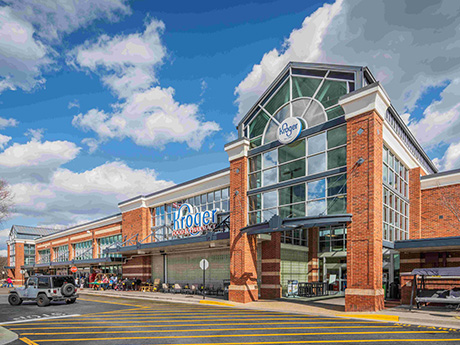Louisville’s retail market continues to show strength in 2025, with grocery anchors driving much of the momentum. Despite national headwinds such as moderating rent growth and elevated construction costs, the metro has proven resilient, posting a vacancy rate of just 3.5 percent, outperforming the national benchmark of 4.8 percent, according to CoStar Group. Asking rents averaged $17.42 per square foot, reflecting steady demand across the region.

At the center of this activity are grocers like Kroger, Publix and BJ’s Wholesale Club, each reshaping Louisville’s retail landscape in unique ways.
Kroger is deepening its footprint with multiple new stores, including a 123,000-square-foot location under construction on Beulah Church Road that is scheduled to open in 2026.
Publix, one of the most closely watched entrants to the Kentucky market, has expanded aggressively after opening its first store, securing 60,000 square feet at Blankenbaker Plaza and 56,000 square feet at Prospect Point.
BJ’s Wholesale Club has adopted a redevelopment approach, razing the former Sears building at Jefferson Mall to deliver a 104,000-square-foot store that opened earlier this year.
Collectively, these projects underscore the draw of essential, needs-based retail while fueling complementary leasing activity in their surrounding trade areas.
Concepts gaining ground
That momentum is spreading to other categories. Quick-service retailers (QSRs) and experiential users continue to fill gaps in the market. Fitness concepts such as TruFit Athletic Clubs and Nova Trampoline Park have opened large-format spaces, while smaller operators — including Starbucks Coffee, Dave’s Hot Chicken and other fast-casual concepts — are targeting outparcels and endcaps near grocery-anchored centers.
The market has also seen notable growth in drive-thru beverage concepts. 7 Brew Coffee has emerged as one of Louisville’s most aggressive operators, opening eight stores in just 18 months, with two more on the way before year-end.
Meanwhile, Dutch Bros Coffee has entered the market with a new store recently opened on Taylorsville Road. These brands, while smaller in square footage, create daily-use vibrancy and bring additional traffic to corridors already anchored by grocery investment.
Equally important is the rise of convenience stores, led by Wawa’s highly anticipated entry into the Louisville market. Wawa currently has one store under construction and at least six additional sites announced, with plans to eventually open 40 locations across Kentucky and Southern Indiana. Each store represents an investment of about $7.5 million, underscoring the chain’s confidence in the market.
QuikTrip and RaceTrac are also expanding in the region, further reinforcing Louisville’s role as a magnet for daily-use, convenience-driven retail. This wave of investment mirrors the success of grocers, bringing essential goods and services closer to consumers while reshaping high-traffic corridors.
Development slows
While new development has slowed — with only 74,000 square feet delivered in the past year, roughly 40 percent below the historical average — the pipeline remains strong. More than 322,000 square feet is under construction that is already 97 percent preleased and dominated by grocery-anchored projects, according to CoStar. This shows that even with higher construction costs, national retailers continue to pursue Louisville aggressively when anchored by necessity-driven tenants.
Investors eye essential retail
Investment activity mirrors these trends. In the past 12 months, 275 properties traded for $297 million, with grocery-anchored centers commanding premium pricing. The $20.3 million sale of Publix at Terra Crossing ($336 per square foot) and Saraga International Grocers’ $21.5 million acquisition of Forum Center illustrate the market’s appetite for essential retail.
Looking ahead, Louisville’s retail story is likely to remain defined by its anchors. Kroger, Publix and BJ’s are setting the pace, while QSR concepts like 7 Brew and Dutch Bros add vibrancy to smaller spaces. Wawa and other convenience players are introducing a new wave of daily-use retail that complements the grocery-led growth.
Together, these dynamics ensure that Louisville remains one of the Southeast’s most compelling retail markets heading into 2026.
— By Casey Smallwood, Senior Vice President, Managing Principal, SRS Real Estate Partners. This article originally appeared in the September 2025 issue of Southeast Real Estate Business.


